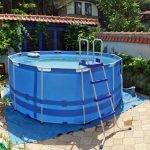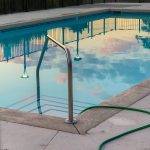The pH test is a dropped based test using color matching. The solution is dropped into a sample of the pool water in the test vial where the color is matched to the level guide. The pH level plays a big role in the comfort of swimmers eyes and skin.
- Rinse the pH test cell with pool water.
- Fill the pH test cell with pool water to the mark.
- Add 5 drops of R-0014 when using the smaller 6 ml square test cell or 5 drops of R-0004 when using the larger 44 ml round test cell.
- Cap the test cell and invert to mix.
- Match the color against the color chart.
- Dispose of the sample safely. It is best to pour it down the drain with the water running. Do not add it back to the pool.
- Rinse the pH test cell with tap water and store for next time.
Notes
- It is easiest to read the color chart when the sample is brightly illuminated. Holding the sample cell up to a sun lit white surface (sheet of paper, white wall, etc) at arms length usually gives the best results. When testing indoors, it helps greatly to have a light box that provides simulated sunlight.
- Some people find that adding an extra drop of reagent, or adjusting the color with either the acid demand or base demand reagents, helps them determine the color more precisely. When using the smaller 6 ml square test cell acid demand is R-0015 and base demand is R-0016. When using the larger 44 ml round test cell acid demand is R-0005 and basedemand is R-0006.
- pH levels lower than 6.8 will read as 6.8. pH levels higher than 8.2 will read as 8.2.
- High FC levels will throw off the test results. The Taylor pH reagent is compensated up to an FC level of 10. When FC is beween 10 and 20 the test will read higher than actual, the reading will be off by more at higher the FC levels. At FC levels somewhat above 20 the phenol red converts to chlorphenol red and will read as 8.2 at any plausible pH level. Chlorphenol red is sometimes used to measure pH levels between 5.2 and 6.6. Some other brands start having problems at much lower FC levels.
- If doing the OTO chlorine test and the pH test at the same time, read the pH color first and then chlorine.
- R-0004 and R-0014 are phenol red, an organic dye that changes color with pH. If the dye stains the plastic bottle it is stored in, it has gone bad.
- The precision of the measurement varies with your skill at distinguishing colors. With practice it is possible to read the level to +-0.1 or better, though many people will get results that are +-0.2 or worse.





